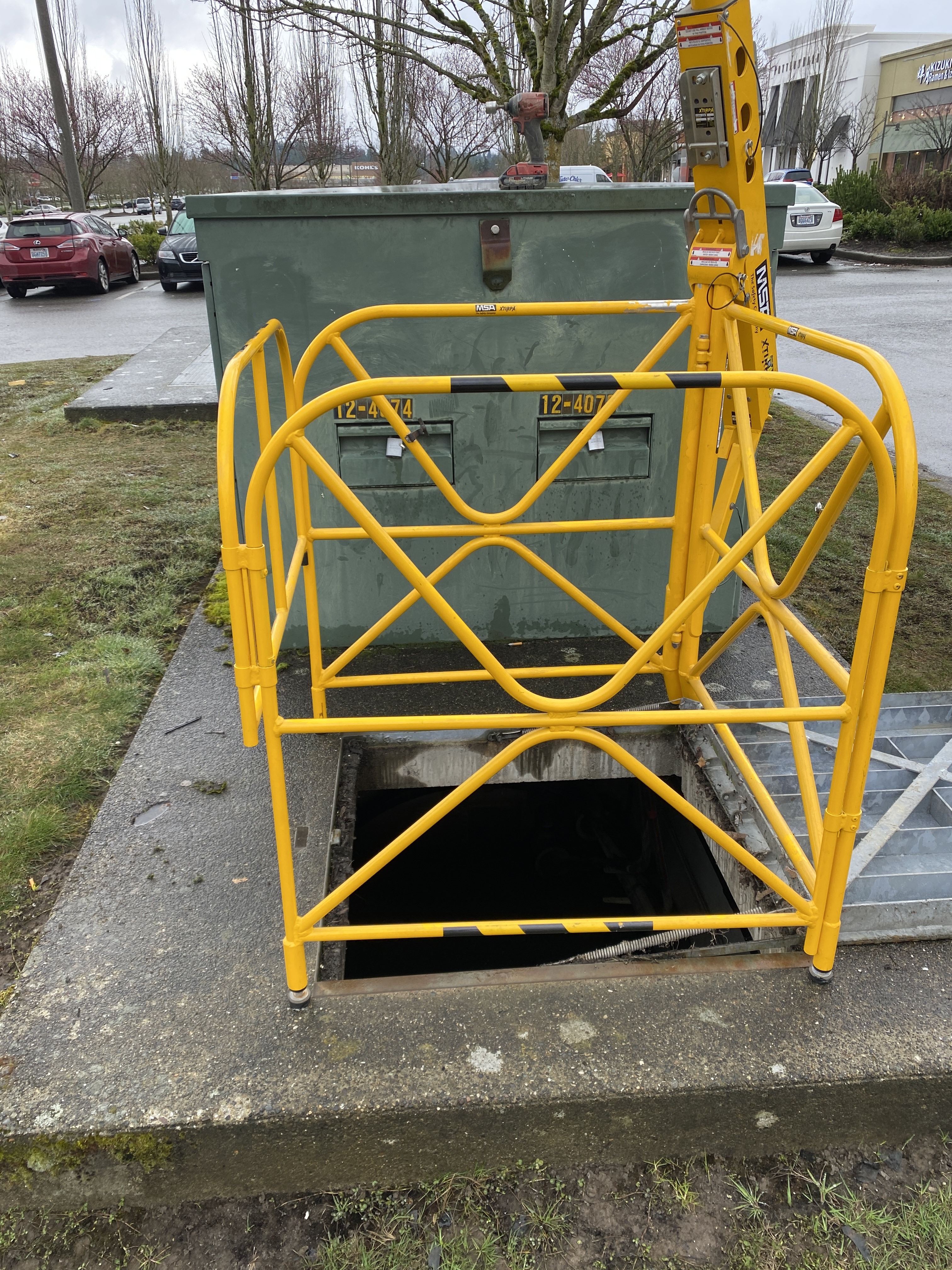Enclosed Space Entry Program
Revised January 2024
Purpose 
The Enclosed Space Program is designed to provide specific direction throughout the District to ensure our employees are afforded a safe workplace, free from recognized hazards. This program identifies employee responsibilities to reduce risk of exposure to hazards associated with enclosed space entry, that may result in serious injury and/or loss of life.
Applicability
The Enclosed Space Entry Program applies to all District employees working under the scope and application of WAC 296-45-205 and WAC 296-45-215, performing URD vault entry. All other confined space entry must follow the Confined Space Entry Program.
Responsibility and Communication
Management Responsibilities
- Implement this program within their scope of responsibility.
- Conduct workplace safety assessments.
- Ensure that employees are trained on enclosed space entry. Note: Training is typically provided by the Line Training Department and throughout the Apprenticeship Program.
- Ensure that employees actively participate in Vault Rescue Training on an annual basis.
- Document locations in GIS that have been flagged as hazardous. For example, vaults that have been identified as containing high levels of hydrogen sulfide (H2S).
Worker Responsibilities
- Discuss the entry procedures during the tailboard.
- Utilize ‘Stop Work Authority’ if conditions change that may require a permit for confined space entry.
- Ensure that rescue techniques are discussed and deployed prior to entry.
- Notify Safety and Management when deficiencies in entry procedures are identified.
- Notify Safety and Management if an enclosed space contains hazardous atmospheric conditions such as H2S.
Safety Department Responsibilities
- Program administration to include audit, inspection, and overall implementation.
- Assist the Tool Room with the selection of gas monitors that meet the requirements of enclosed and confined space entry requirements.
- Participate in risk assessments, program development and management implementation.
Enclosed Space Entry Procedure
- Prior to entering an enclosed space:
- Ensure that you have a calibrated and bump tested gas monitor.
- Conduct a tailboard meeting with the crew that includes entry and rescue procedures.
- Evaluate the space for thermal or pressure hazards.
- Test the space prior to removing a cover or opening the enclosed space lid.
- The space must be in a sanitary condition. If there is evidence of sewage or biohazard, it must be cleaned prior to entry. Consult Safety for additional support.
- Removing enclosed space covers:
- When covers are removed that exceed 4’ in depth, guardrails or other protective barriers must be installed to prevent accidental falls into the enclosed space.
- Test for atmospheric hazards (oxygen deficiency, flammable gas, and vapor, H2S) Note: The districts 4-gas meters are supplied with a hose that can be used to test atmospheric conditions at various depths from the ground level.
- If flammable gases or oxygen deficiency if identified, forced ventilation must be utilized with continuous monitoring prior to entry.
- Entry into an enclosed space is prohibited if the atmospheric hazards cannot be eliminated by ventilation. See the Confined Space Entry Program for additional entry procedures.
- Entry:
- The atmosphere must be safe to enter by testing and ventilation (if needed)
- An access ladder must be used for all spaces that exceed 4’ in depth.
- Continuous air monitoring is required.
- An attendant must be assigned at the surface and be able to always monitor activity in the enclosed space.
- Materials must not be thrown into or out of manholes but must be placed in the proper receptacle and hoisted in and out by means of a handline or hoist.
- Open Flames: If open flames are used in enclosed spaces, a test for flammable gases and vapors must be made immediately before the open flame device is used, and at least once per hour while the device is used in the space. Testing must be conducted more frequently if conditions present in the enclosed space indicate that once per hour is insufficient to detect hazardous accumulations of flammable gases or vapors.
- Rescue:
- Rescue equipment must be available and readily deployed in the event of an emergency.
- Employees must be trained and proficient in the means and methods of the District’s rescue techniques and equipment on an annual basis.
Definitions
Enclosed Space: This section applies to routine entry into enclosed spaces in lieu of the permit-space entry requirements contained in chapter 296-809 WAC. If, after the employer takes the precautions given in WAC 296-45-205, 296-45-215, and 296-45-225, the hazards remaining in the enclosed space endanger the life of an entrant or could interfere with an entrant’s escape from the space, then entry into the enclosed space must meet the permit-space entry requirements of chapter WAC 296-809.
Attendant: An employee with first-aid training that is immediately available outside the enclosed space to monitor activity and available to provide assistance.
Entry: The action where any part of a person’s body breaks the plane (passes through an opening) into a confined space. Entry occurs as soon as any part of the entrant’s body breaks the plane of the opening into the space whether or not such action is intentional, or any work activities are actually performed in the space.
Hazardous Atmosphere: An atmosphere that may expose employees to the risk of death, incapacitation, impair their ability to self-rescue (escape unaided from a permit-required confined space), injury, or acute illness caused by one or more of the following:
- Flammable gas, vapor, or mist in excess of ten percent of its lower flammable limit (LFL) or lower explosive limit (LEL).
- Airborne combustible dust at a concentration that meets or exceeds its LFL. The concentration may be approximated as a condition in which the dust obscures vision at a distance of five feet or less.
- Atmospheric oxygen concentration below 19.5 percent or above 23.5 percent
- Atmospheric concentration of any substance which may exceed a permissible exposure limit. (PEL)
- Any other atmospheric condition that is immediately dangerous to life or health.